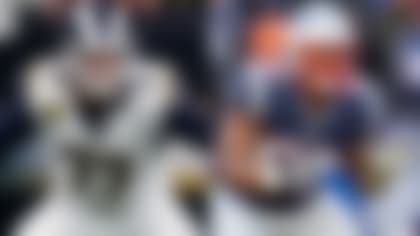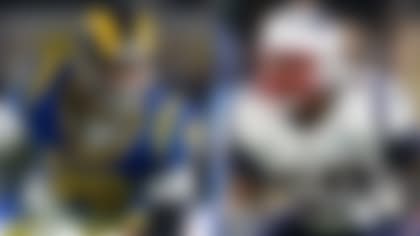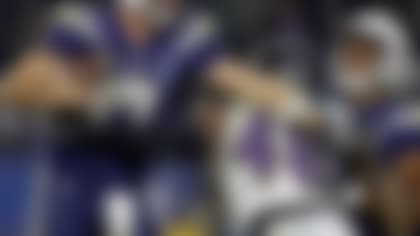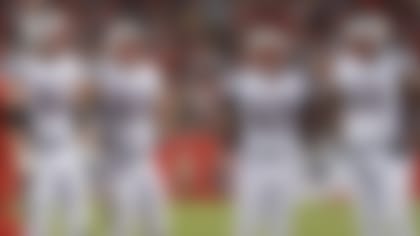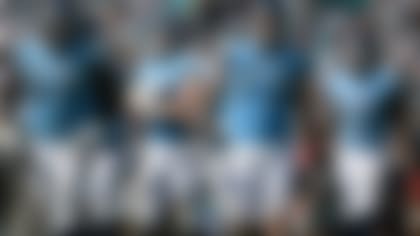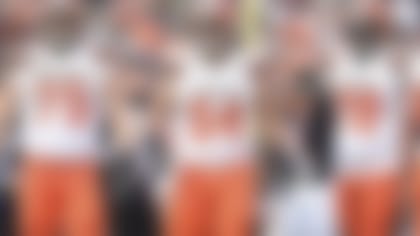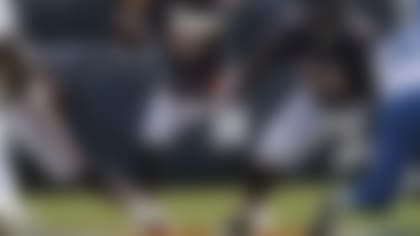The Indianapolis Colts entered the 2018 season with relatively low expectations. Coming off a 4-12 season that saw the firing of Chuck Pagano and never produced an appearance from Andrew Luck, Indianapolis was seen as a team still rebuilding.
New head coach Frank Reich surprised some by speaking with confidence about his team's potential during camp and how they'd approach the season. It sounded like hot air through the first six weeks, with the Colts losing five of their first six.
Then a change up front spurred a turnaround unseen by almost everyone. Since Anthony Castonzo made his season debut, Mark Glowinski moved to starting right guard in place of the injured Matt Slauson, and rookie Braden Smith shifted from right guard to tackle (in place of Denzelle Good) all in Week 6, the Colts haven't given up a sack. Even better, they've only lost one game.
Let's go Behind the O Line to figure out what has taken the Colts from the league's worst to one of the NFL's fastest rising groups up front.
The Colts take on a different identity with each week, all with two common threads: A commitment to protecting Luck, and a dedicated effort to establish a ground game.
From Weeks 7-10, Indianapolis approached each game differently. Against Buffalo, the Colts relied on a power-heavy scheme littered with lead blocks from guard Quenton Nelson, fullback Ryan Hewitt, center Ryan Kelly and Glowinski. In Week 8, they relied less on lead blockers and more on interior double teams, grinding down the Raiders on the inside, which paid off late with run-heavy drives that produced touchdowns in a 42-28 win. And then in Week 10 (following a Week 9 bye), they came out firing quick passes in an effort to limit Jacksonville's pass-rushing effectiveness -- especially in the matchup between Smith and Calais Campbell.
Part of why this Colts offense is effective because Reich feels free to run plays that require running backs to find and choose holes. It's evident on typical zone run plays, but even more when the Colts run multiple cross blocks up front, naturally creating lanes for runners to choose. They did so in each of the games from Weeks 7-10.
The Colts mix in zone but use a variety of concepts, including plenty of pulling and lead blocking. My favorite example of this came in Week 10 on a play you've most likely seen if you pay attention to #FootballTwitter. You know, that clip that shows Nelson coming out of his stance screaming until he makes contact with Jaguars safety Barry Church?
Despite the eventual revelation that the sound was dubbed over the clip, the play isn't any less remarkable. It was the first time in any of the Colts' games from Weeks 7-10 that I saw this action up front.
Indianapolis' entire line takes an initial zone step left, and for a brief moment, it looks like a zone run to the left. But then, Nelson plants that left foot into the ground, pivots and fires out laterally as he swings open his right hip to pull to the right. On the right, Glowinski takes a half step more than Nelson, shuffling left like a basketball defender before planting and opening his right hip to pull in front of Nelson. Marlon Mack takes a misdirection path from the shotgun, taking the handoff with his two guards in front of him.
The fake action to the left sends Church and linebacker Telvin Smith into a read step to their right (Colts' left), giving Nelson and Glowinski a beat's advantage in their pulls. Glowinski kicks out defensive back Tyler Patmon, while Nelson, just off Glowinski's hip, turns upfield to meet Church, who he promptly plants into the turf.
It was like watching offensive line ballet.
They did it again later in the first quarter, on a play with a blocking scheme known as a pin and pull. It wasn't as pronounced as the first, nor did it have the same effect, resulting in a rush for no gain.
There was also the occasional perimeter toss from the Colts, which is a surprise only because Indianapolis doesn't turn to it often, considering how well its linemen can pull and block in space. All five of Indianapolis' linemen can pull and do so quite well, with Kelly, Nelson and Glowinski all battling amongst one another for the title of best puller.
On this toss to Jordan Wilkins against Jacksonville, Glowinski again pulls correctly and cuts down a defender, while Smith leads on the inside and engages Tashaun Gipson long enough for Wilkins to get past him for a gain of 53.
The key on this play, surprisingly, us the blocking of receiver Dontrelle Inman, who engages and maintains a block on corner D.J. Hayden (a former Colt) more than long enough for Wilkins to hit the edge with a full head of steam. It's a pleasant change for the Colts, who don't get the best blocking from receivers, namely Chester Rogers.
Kelly is a really effective center in all facets of the game. He embarks on some ambitious paths as a puller in both the run and pass game and rarely has an issue with finding and handling a man. On this play-action pass to Jack Doyle, he sells the fake right before doubling back to cover Luck's frontside from an unblocked rusher. Kelly meets Arden Key with considerable distance between them and Luck, who dumps it off to Doyle for a gain of nine.
While this play wasn't the most eye-opening pull, it was an example of how Kelly can do just about anything from the center position. The Colts ask a lot of Kelly, and he answers the bell time and time again.
When I watch Kelly and Nelson block in space, I feel like I'm watching twins, or brothers who grew up just a couple of years apart. They move in sync as if they've played together for years, and each are effective.
Indianapolis loses virtually nothing at the other guard, too. While Nelson appears on track for multiple All-Pro honors in his career, Glowinski is more than doing his share.
In fact, if I had to pick a weak link, it's Smith. That's not saying much, though, because the rookie appears to be improving with each week as he learns his second position, though Jacksonville presented a tall task that was an obvious struggle at times. The Jaguars pressured Luck better than any of the other teams the Colts faced from Weeks 7-11.
When it comes to pass protection, we all know about Indianapolis' sack-free streak that has now reached five games. The Colts are solid up front and avoid sacks because they have safety valves built into plays. On their first possession against the Buffalo Bills in Week 7, the Colts handled a blitz well, picking up all but one rusher. Instead of taking the sack, Luck wisely dumped the ball off to Mack, though it ended in an incompletion.
A balanced, mixed offense also allows the Colts to run play action well. They ran it to perfection early in Week 7, with the help of (sneaky good) fullback Ryan Hewitt, who crossed behind the line from the wingback position to pick up a blitzing Matt Milano in the A gap. A six-man rush was stopped in its tracks by the line, thanks to a really excellent feel for space and pressure displayed by Nelson, who gave a hand to defensive tackle Harrison Phillips to judge the space allotted before picking up linebacker Tremaine Edmunds. It produced a solid front and plenty of time for Luck to complete the run fake, step up and deliver to Rogers for a gain of 13.
Sometimes the Colts linemen cram together in pass protection to form a wall, and they did so on a run against the Bills, too. Another example came in Week 8, when a stunt run by Raiders defensive end Fadol Brown and defensive tackle Maurice Hurst went nowhere thanks to the play of Kelly, who slid to his right and drove Brown into the ground as Luck completed a pass for an 11-yard gain.
While Reich's offense is open-minded and employs a variety of different schemes, it's also consistently dedicated to interior victories, even when it isn't producing huge results. Against Oakland, the Colts ran a ton of interior runs with simultaneous Ace (a center-guard double team) and Deuce (guard-tackle double teams) blocks on opposing down linemen. It worked pretty well, though at times, Doyle struggled to win the inside against Brown.
These efforts came to a head late in what was a close game, with the Colts repeatedly pounding the ball up the middle off the rear ends of the linemen executing these double teams. Indianapolis successfully wore down Oakland's front four, so much that when Glowinski teamed with Smith to drive Hurst into the ground and Mack ran over them to score the go-ahead touchdown late in the fourth quarter, it seemed as if it was only a matter of when, not if.
And when it comes to Nelson, the No. 6 overall pick in the 2018 draft, he's every bit as good as advertised. He often teams with Kelly to move defenders, but can handle them on his own just fine. On this touchdown run to open scoring in Week 11, he fires out, engages Jurrell Casey (a problem-causer for nearly every lineman he faces) and drives him right out of the play. It's no surprise Kelly is at the second level on this play, pushing linebacker Wesley Woodyard right out of the action.
Mack has plenty of room to run, breaking a tackle attempt by Logan Ryan to score a touchdown. It's starting to become a common theme with these Colts.
Overall, this group continues to get better each week. They saw a huge jump in production after Reich's staff slid Glowinski inside to guard and inserted Smith at tackle in place of Good. It's no coincidence that the Colts suddenly started winning games after making this change.
With this group, it seems the sky is the limit. Backup interior lineman Evan Boehm will have to replace Kelly, who is an essential part of their success and will miss Week 12's matchup with Miami due to a knee injury. His status will be incredibly important to the Colts' fortunes in the final five weeks of the season.
But the Colts aren't held to just a few different approaches thanks to the versatility of the line, and with Luck behind them with time to throw, they're a handful to stop. Where that leads them is anyone's guess as we enter the final six weeks of the season, but it's a tangible reason for those supporting the horseshoe-helmeted men to feel very good about the future.

